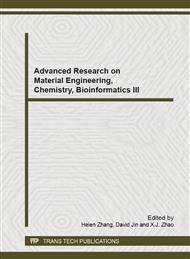[1]
Van De Weijer J, Schmid C. Coloring local feature extraction[M]/Computer Vision–ECCV 2006. Springer Berlin Heidelberg, 2006: 334-348.
DOI: 10.1007/11744047_26
Google Scholar
[2]
Yu N, Qiu T, Bi F, et al. Image features extraction and fusion based on joint sparse representation[J]. Selected Topics in Signal Processing, IEEE Journal of, 2011, 5(5): 1074-1082.
DOI: 10.1109/jstsp.2011.2112332
Google Scholar
[3]
Yang B, Li S. Multifocus image fusion and restoration with sparse representation[J]. Instrumentation and Measurement, IEEE Transactions on, 2010, 59(4): 884-892.
DOI: 10.1109/tim.2009.2026612
Google Scholar
[4]
Fernando B, Fromont E, Muselet D, et al. Discriminative feature fusion for image classification[C]/Computer Vision and Pattern Recognition (CVPR), 2012 IEEE Conference on. IEEE, 2012: 3434-3441.
DOI: 10.1109/cvpr.2012.6248084
Google Scholar
[5]
Khan F S, Weijer J, Bagdanov A D, et al. Portmanteau vocabularies for multi-cue image representation[C]/Advances in neural information processing systems. 2011: 1323-1331.
Google Scholar
[6]
Yao B, Khosla A, Fei-Fei L. Combining randomization and discrimination for fine-grained image categorization[C]/Computer Vision and Pattern Recognition (CVPR), 2011 IEEE Conference on. IEEE, 2011: 1577-1584.
DOI: 10.1109/cvpr.2011.5995368
Google Scholar
[7]
Ye G, Liu D, Jhuo I H, et al. Robust late fusion with rank minimization[C]/Computer Vision and Pattern Recognition (CVPR), 2012 IEEE Conference on. IEEE, 2012: 3021-3028.
DOI: 10.1109/cvpr.2012.6248032
Google Scholar
[8]
B. Efron, T. Hastie, L. Johnstone, and R. Tibshirani. Least angle regression. Annals of Statistics, 32: 407–499, (2004).
DOI: 10.1214/009053604000000067
Google Scholar
[9]
Chiang C K, Duan C H, Lai S H, et al. Learning component-level sparse representation using histogram information for image classification[C]/Computer Vision (ICCV), 2011 IEEE International Conference on. IEEE, 2011: 1519-1526.
DOI: 10.1109/iccv.2011.6126410
Google Scholar
[10]
Van De Weijer J, Schmid C, Verbeek J, Learning color names from real-world images, in: Proc. Computer Vision and Pattern Recognition, (2007).
DOI: 10.1109/cvpr.2007.383218
Google Scholar


